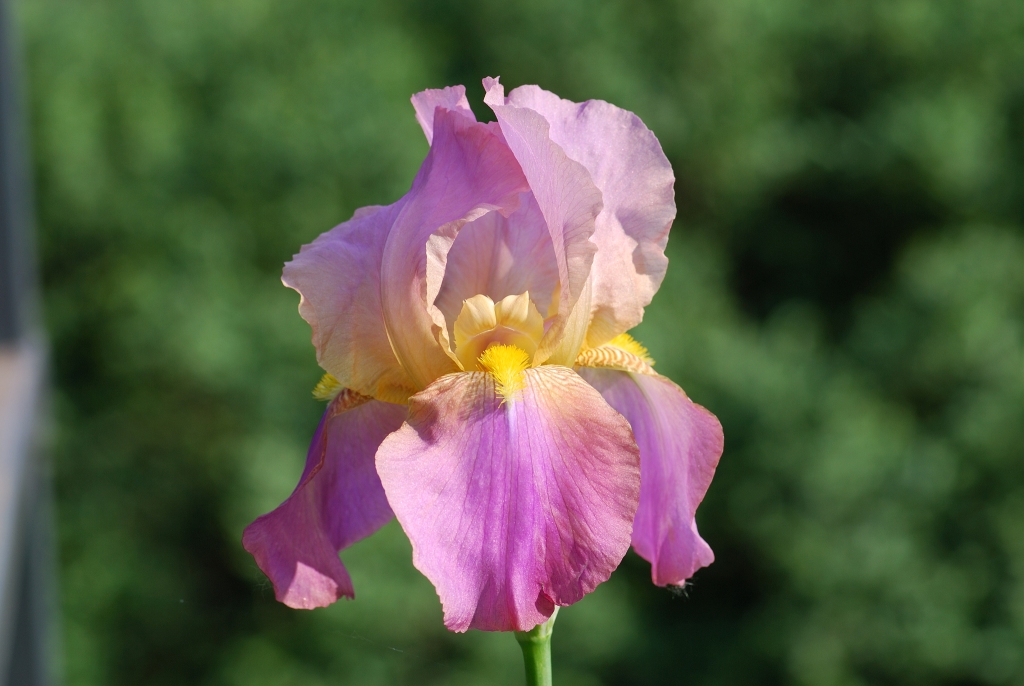The Iridaceae family is a group of monocotyledonous plants in the order Asparagales, comprising about 80 genera and approximately 1,800 species. This family is primarily made up of herbaceous perennials, many of which are ornamental and highly valued for their colorful and showy flowers. The plants of the Iridaceae family are found mostly in temperate and tropical regions, but they are especially common in arid and semi-arid zones.
General Description
Plants in the Iridaceae family typically have the following characteristics:
- Leaves: The leaves are generally long, narrow, and sword-shaped, arranged alternately or in a basal rosette. The leaves are often fleshy and have a smooth, glossy surface.
- Flowers: The flowers are characterized by six tepals, arranged in radial symmetry, and display a wide range of colors, including purple, yellow, blue, orange, and white. The flowers are often large and showy, with a shape that can vary from bell-shaped to cup-like, and they are usually solitary or arranged in inflorescences.
- Fruits: The fruits are typically capsules containing numerous seeds, which are dispersed by wind or water.
- Roots: The plants in the Iridaceae family may be rhizomatous or bulbous, with roots that allow them to survive during periods of drought.
Chemical Composition
Plants in the Iridaceae family are known to contain several bioactive compounds. Some of the primary compounds include:
- Alkaloids: Some species in the family contain alkaloids that may have medicinal effects, though in some plants, these alkaloids can be toxic. For example, glaucine in Gladiolus is a compound that has shown effects on the nervous system.
- Flavonoids: Flavonoids in the family contribute to antioxidant and anti-inflammatory properties, which help combat oxidative stress and protect both plants and humans from chronic diseases.
- Saponins: Saponins are present in some species of the Iridaceae family, where they help defend the plants against pathogens and promote their resilience.
- Phenolic Acids: These compounds contribute to the antioxidant and antimicrobial properties of the plants.
Physical Properties
Plants in the Iridaceae family generally exhibit the following physical traits:
- Stems and Roots: The species in the Iridaceae family are primarily herbaceous, with slender, often unbranched stems. Many species, like those in the Iris genus, are rhizomatous, with rhizomes that allow the plant to develop perennially, renewing itself each season. Other species, like those in the Crocus genus, are bulbous, with bulbs that store nutrients during dormancy.
- Leaves: The leaves are long and narrow, typically sword-shaped. They are arranged in a basal rosette or alternately along the stem.
- Flowers: Flowers are often large, showy, and fragrant, with six tepals (three outer and three inner), and they often attract insect pollinators like bees and butterflies.
- Fruits: The fruits are typically capsules containing numerous seeds, which are dispersed once the capsule ripens and opens.
Production Process
Plants in the Iridaceae family are primarily propagated by seed, although many species can also be propagated by division of the rhizomes or bulbs. Seeds are typically sown in spring or fall, depending on the climate, while rhizome or bulb division is done to encourage the growth of new plants.
Ornamental species like Iris and Crocus are cultivated in nurseries or gardens, where they are cared for for their decorative flowers. Some genera, such as Iris, are also grown for the extraction of compounds used in the cosmetic industry.
Applications
Medicinal
Some species in the Iridaceae family have medicinal applications:
- Gladiolus: The roots of some gladiolus species have been used in folk medicine to treat respiratory ailments and as expectorants. The alkaloids found in the plant have also been studied for their therapeutic potential.
- Iris: The roots of certain Iris species, like Iris germanica, have been used in herbal medicine to treat skin diseases and respiratory infections. The extracts are believed to have diuretic and purifying effects.
Ornamental
The Iridaceae family is highly valued for its ornamental plants:
- Iris (Iris spp.): Known for its large, colorful, and fragrant flowers, iris is one of the most cultivated ornamental plants in gardens. Iris varieties are prized for their elegant flowers and bright colors.
- Crocus (Crocus spp.): Famous for its vibrant spring flowers, especially the autumn crocus (Crocus sativus), which produces saffron, a highly valued spice.
- Gladiolus (Gladiolus spp.): With its large, colorful flowers, gladiolus is widely used in floral arrangements and as an ornamental plant in gardens.
Culinary
Crocus sativus is well-known for producing saffron, one of the most expensive spices in the world. Saffron is used to add color and flavor to traditional dishes in many cuisines, including Mediterranean, Asian, and Middle Eastern cooking.
Environmental and Safety Considerations
Plants in the Iridaceae family are generally safe for ornamental and culinary uses, but some species can be toxic if consumed improperly. For example, some Iris species can contain compounds that may cause gastrointestinal irritation if ingested.
The alkaloids present in species like Gladiolus should be handled with care, as they can be toxic in high doses.
INCI Functions
- Antioxidant: Protects the skin from oxidative stress.
- Soothing: Reduces inflammation and redness in the skin.
- Antimicrobial: Fights harmful microorganisms on the skin.
- Moisturizing: Helps maintain skin hydration.
Conclusion
The Iridaceae family is a highly significant group, especially for its ornamental value and medicinal applications. Plants like Iris, Crocus, and Gladiolus are widely appreciated in gardens for their vibrant flowers and ability to adapt to various soil types. Some species, like Crocus sativus, are also essential in the food industry for saffron production. The plants in the Iridaceae family offer numerous ecological and practical benefits, and with proper care, they continue to play an important role in both garden decoration and the pharmaceutical and culinary industries.
![]() Iridaceae
Iridaceae 

